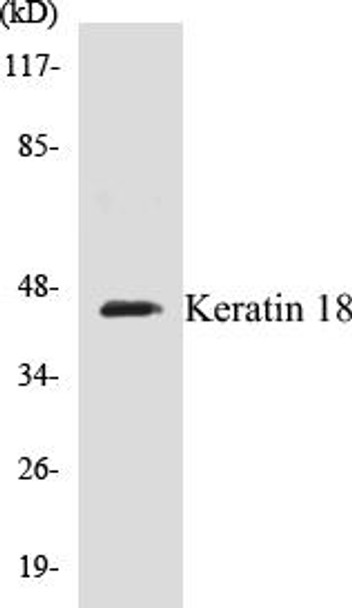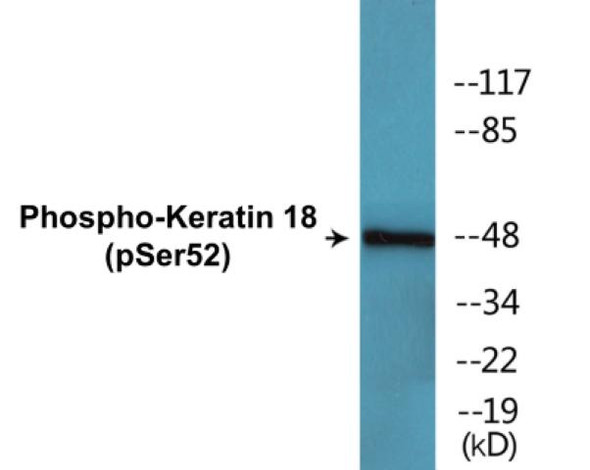Description
Keratin 18 Colorimetric Cell-Based ELISA Kit
The Keratin 18 Colorimetric Cell-Based ELISA Kit from Assay Genie is a comprehensive solution for the quantitative measurement of Keratin 18 levels in various biological samples, including serum, plasma, and cell culture supernatants. This kit is designed to offer high sensitivity and specificity, ensuring accurate and reproducible results for a range of research applications.Keratin 18 is a key intermediate filament protein that plays a crucial role in maintaining the structural integrity of epithelial cells. Dysregulation of Keratin 18 expression has been linked to various diseases, including liver diseases, inflammatory bowel diseases, and cancer.
As such, the Keratin 18 Colorimetric Cell-Based ELISA Kit provides researchers with a valuable tool for studying the role of Keratin 18 in disease development and progression, as well as for exploring potential therapeutic targets.Whether you are investigating the pathophysiology of a specific disease or exploring new treatment options, the Keratin 18 Colorimetric Cell-Based ELISA Kit offers a reliable and efficient method for quantifying Keratin 18 levels in biological samples. Trust Assay Genie for all your research needs and unlock the potential of Keratin 18 as a biomarker for various health conditions.
| Product Name: | Keratin 18 Colorimetric Cell-Based ELISA |
| Product Code: | CBCAB00321 |
| ELISA Type: | Cell-Based |
| Target: | Keratin 18 |
| Reactivity: | Human, Mouse, Rat |
| Dynamic Range: | > 5000 Cells |
| Detection Method: | Colorimetric 450 nmStorage/Stability:4°C/6 Months |
| Format: | 96-Well Microplate |
The Keratin 18 Colorimetric Cell-Based ELISA Kit is a convenient, lysate-free, high throughput and sensitive assay kit that can detect Keratin 18 protein expression profile in cells. The kit can be used for measuring the relative amounts of Keratin 18 in cultured cells as well as screening for the effects that various treatments, inhibitors (ie siRNA or chemicals), or activators have on Keratin 18.
Qualitative determination of Keratin 18 concentration is achieved by an indirect ELISA format. In essence, Keratin 18 is captured by Keratin 18-specific primary antibodies while the HRP-conjugated secondary antibodies bind the Fc region of the primary antibody. Through this binding, the HRP enzyme conjugated to the secondary antibody can catalyze a colorimetric reaction upon substrate addition. Due to the qualitative nature of the Cell-Based ELISA, multiple normalization methods are needed:
| 1. | A monoclonal antibody specific for human GAPDH is included to serve as an internal positive control in normalizing the target absorbance values. |
| 2. | Following the colorimetric measurement of HRP activity via substrate addition, the Crystal Violet whole-cell staining method may be used to determine cell density. After staining, the results can be analysed by normalizing the absorbance values to cell amounts, by which the plating difference can be adjusted. |
| Database Information: | Gene ID: 3875, UniProt ID: P05783, OMIM: 148070/215600, Unigene: Hs.406013 |
| Gene Symbol: | KRT18 |
| Sub Type: | None |
| UniProt Protein Function: | K18: a type I cytoskeletal keratin. The keratins are intermediate filament proteins responsible for the structural integrity of epithelial cells and are subdivided into cytokeratins and hair keratins. Keratin 18 and its filament partner keratin 8 are perhaps the most commonly found members of the intermediate filament gene family. They are expressed in single layer epithelial tissues of the body. Defects are a cause of cryptogenic cirrhosis. |
| UniProt Protein Details: | Protein type:Nucleolus; Cytoskeletal Chromosomal Location of Human Ortholog: 12q13 Cellular Component: cytoplasm; intermediate filament; keratin filament; microtubule organizing center; nucleolus; perinuclear region of cytoplasm Molecular Function:protein binding; structural molecule activity Biological Process: anatomical structure morphogenesis; cell cycle; Golgi to plasma membrane CFTR protein transport; intermediate filament cytoskeleton organization and biogenesis; negative regulation of apoptosis; tumor necrosis factor-mediated signaling pathway; viral reproduction Disease: Cirrhosis, Familial |
| NCBI Summary: | KRT18 encodes the type I intermediate filament chain keratin 18. Keratin 18, together with its filament partner keratin 8, are perhaps the most commonly found members of the intermediate filament gene family. They are expressed in single layer epithelial tissues of the body. Mutations in this gene have been linked to cryptogenic cirrhosis. Two transcript variants encoding the same protein have been found for this gene. [provided by RefSeq, Jul 2008] |
| UniProt Code: | P05783 |
| NCBI GenInfo Identifier: | 125083 |
| NCBI Gene ID: | 3875 |
| NCBI Accession: | P05783.2 |
| UniProt Secondary Accession: | P05783,Q53G38, Q5U0N8, Q9BW26, |
| UniProt Related Accession: | P05783 |
| Molecular Weight: | |
| NCBI Full Name: | Keratin, type I cytoskeletal 18 |
| NCBI Synonym Full Names: | keratin 18 |
| NCBI Official Symbol: | KRT18 |
| NCBI Official Synonym Symbols: | K18; CK-18; CYK18 |
| NCBI Protein Information: | keratin, type I cytoskeletal 18 |
| UniProt Protein Name: | Keratin, type I cytoskeletal 18 |
| UniProt Synonym Protein Names: | Cell proliferation-inducing gene 46 protein; Cytokeratin-18; CK-18; Keratin-18; K18 |
| Protein Family: | Keratin |
| UniProt Gene Name: | KRT18 |
| UniProt Entry Name: | K1C18_HUMAN |
| Component | Quantity |
| 96-Well Cell Culture Clear-Bottom Microplate | 2 plates |
| 10X TBS | 24 mL |
| Quenching Buffer | 24 mL |
| Blocking Buffer | 50 mL |
| 15X Wash Buffer | 50 mL |
| Primary Antibody Diluent | 12 mL |
| 100x Anti-Phospho Target Antibody | 60 µL |
| 100x Anti-Target Antibody | 60 µL |
| Anti-GAPDH Antibody | 60 µL |
| HRP-Conjugated Anti-Rabbit IgG Antibody | 12 mL |
| HRP-Conjugated Anti-Mouse IgG Antibody | 12 mL |
| SDS Solution | 12 mL |
| Stop Solution | 24 mL |
| Ready-to-Use Substrate | 12 mL |
| Crystal Violet Solution | 12 mL |
| Adhesive Plate Seals | 2 seals |
The following materials and/or equipment are NOT provided in this kit but are necessary to successfully conduct the experiment:
- Microplate reader able to measure absorbance at 450 nm and/or 595 nm for Crystal Violet Cell Staining (Optional)
- Micropipettes with capability of measuring volumes ranging from 1 µL to 1 ml
- 37% formaldehyde (Sigma Cat# F-8775) or formaldehyde from other sources
- Squirt bottle, manifold dispenser, multichannel pipette reservoir or automated microplate washer
- Graph paper or computer software capable of generating or displaying logarithmic functions
- Absorbent papers or vacuum aspirator
- Test tubes or microfuge tubes capable of storing ≥1 ml
- Poly-L-Lysine (Sigma Cat# P4832 for suspension cells)
- Orbital shaker (optional)
- Deionized or sterile water
*Note: Protocols are specific to each batch/lot. For the correct instructions please follow the protocol included in your kit.
| Step | Procedure |
| 1. | Seed 200 µL of 20,000 adherent cells in culture medium in each well of a 96-well plate. The plates included in the kit are sterile and treated for cell culture. For suspension cells and loosely attached cells, coat the plates with 100 µL of 10 µg/ml Poly-L-Lysine (not included) to each well of a 96-well plate for 30 minutes at 37°C prior to adding cells. |
| 2. | Incubate the cells for overnight at 37°C, 5% CO2. |
| 3. | Treat the cells as desired. |
| 4. | Remove the cell culture medium and rinse with 200 µL of 1x TBS, twice. |
| 5. | Fix the cells by incubating with 100 µL of Fixing Solution for 20 minutes at room temperature. The 4% formaldehyde is used for adherent cells and 8% formaldehyde is used for suspension cells and loosely attached cells. |
| 6. | Remove the Fixing Solution and wash the plate 3 times with 200 µL 1x Wash Buffer for five minutes each time with gentle shaking on the orbital shaker. The plate can be stored at 4°C for a week. |
| 7. | Add 100 µL of Quenching Buffer and incubate for 20 minutes at room temperature. |
| 8. | Wash the plate 3 times with 1x Wash Buffer for 5 minutes each time. |
| 9. | Add 200 µL of Blocking Buffer and incubate for 1 hour at room temperature. |
| 10. | Wash 3 times with 200 µL of 1x Wash Buffer for 5 minutes each time. |
| 11. | Add 50 µL of 1x primary antibodies (Anti-Keratin 18 Antibody and/or Anti-GAPDH Antibody) to the corresponding wells, cover with Parafilm and incubate for 16 hours (overnight) at 4°C. If the target expression is known to be high, incubate for 2 hours at room temperature. |
| 12. | Wash 3 times with 200 µL of 1x Wash Buffer for 5 minutes each time. |
| 13. | Add 50 µL of 1x secondary antibodies (HRP-Conjugated AntiRabbit IgG Antibody or HRP-Conjugated Anti-Mouse IgG Antibody) to corresponding wells and incubate for 1.5 hours at room temperature. |
| 14. | Wash 3 times with 200 µL of 1x Wash Buffer for 5 minutes each time. |
| 15. | Add 50 µL of Ready-to-Use Substrate to each well and incubate for 30 minutes at room temperature in the dark. |
| 16. | Add 50 µL of Stop Solution to each well and read OD at 450 nm immediately using the microplate reader. |
(Additional Crystal Violet staining may be performed if desired – details of this may be found in the kit technical manual.)






